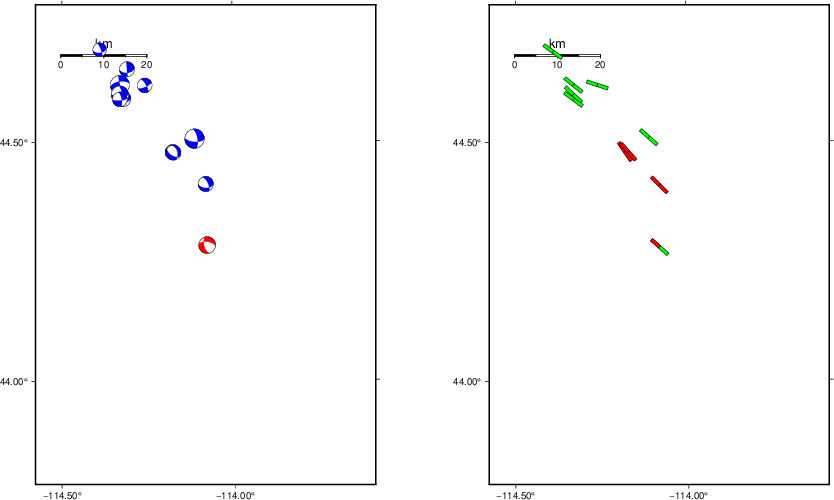Location
Location ANSS
The ANSS event ID is us6000qiz0 and the event page is at
https://earthquake.usgs.gov/earthquakes/eventpage/us6000qiz0/executive.
2025/06/08 17:05:46 44.284 -114.077 8.4 4.3 Idaho
Focal Mechanism
USGS/SLU Moment Tensor Solution
ENS 2025/06/08 17:05:46.0 44.28 -114.08 8.4 4.3 Idaho
Stations used:
IE.BCYI IE.NPRI IW.DLMT IW.LOHW IW.MFID IW.MOOW IW.PLID
IW.SNOW IW.TPAW MB.BCMT MB.BDMT MB.BNMT MB.CPMT MB.FCMT
MB.GBMT MB.HRY MB.JTMT MB.LIMT MB.LRM MB.ODMT MB.SMMT
MB.SRMT MB.SXMT MB.WCMT UO.JAZZ US.AHID US.BMO US.BOZ
US.BW06 US.ELK US.HLID US.HWUT US.MSO US.RLMT US.WVOR
UU.BEID UU.BGU UU.CTU UU.HDUT UU.HVU UU.MCU UU.NOQ UU.SPU
UU.TCU UW.AGNW UW.BRAN UW.BURN UW.IRON UW.IZEE UW.LBRT
UW.LNO UW.TUCA UW.UMAT UW.YPT WW.BILL WW.CNCL WW.CTNW
WW.IRMR WW.TYLR WY.YDD WY.YFT WY.YHB WY.YMP WY.YMR WY.YPP
Filtering commands used:
cut o DIST/3.3 -30 o DIST/3.3 +60
rtr
taper w 0.1
hp c 0.03 n 3
lp c 0.08 n 3
Best Fitting Double Couple
Mo = 2.43e+22 dyne-cm
Mw = 4.19
Z = 10 km
Plane Strike Dip Rake
NP1 165 60 -40
NP2 278 56 -143
Principal Axes:
Axis Value Plunge Azimuth
T 2.43e+22 2 222
N 0.00e+00 42 314
P -2.43e+22 48 130
Moment Tensor: (dyne-cm)
Component Value
Mxx 8.95e+21
Mxy 1.73e+22
Mxz 6.96e+21
Myy 4.55e+21
Myz -9.94e+21
Mzz -1.35e+22
-#############
----##################
-------#####################
-------#######################
---------#########################
---------###########################
---------------------#################
-----######------------------###########
--#########----------------------#######
#############------------------------#####
#############--------------------------###
#############---------------------------##
##############----------------------------
#############-------------- ----------
##############------------- P ----------
##############------------ ---------
##############----------------------
##############--------------------
##########-----------------
T ############--------------
#############---------
###########---
Global CMT Convention Moment Tensor:
R T P
-1.35e+22 6.96e+21 9.94e+21
6.96e+21 8.95e+21 -1.73e+22
9.94e+21 -1.73e+22 4.55e+21
Details of the solution is found at
http://www.eas.slu.edu/eqc/eqc_mt/MECH.NA/20250608170546/index.html
|
Preferred Solution
The preferred solution from an analysis of the surface-wave spectral amplitude radiation pattern, waveform inversion or first motion observations is
STK = 165
DIP = 60
RAKE = -40
MW = 4.19
HS = 10.0
The NDK file is 20250608170546.ndk
The waveform inversion is preferred.
Moment Tensor Comparison
The following compares this source inversion to those provided by others. The purpose is to look for major differences and also to note slight differences that might be inherent to the processing procedure. For completeness the USGS/SLU solution is repeated from above.
| SLU |
USGSMWR |
USGS/SLU Moment Tensor Solution
ENS 2025/06/08 17:05:46.0 44.28 -114.08 8.4 4.3 Idaho
Stations used:
IE.BCYI IE.NPRI IW.DLMT IW.LOHW IW.MFID IW.MOOW IW.PLID
IW.SNOW IW.TPAW MB.BCMT MB.BDMT MB.BNMT MB.CPMT MB.FCMT
MB.GBMT MB.HRY MB.JTMT MB.LIMT MB.LRM MB.ODMT MB.SMMT
MB.SRMT MB.SXMT MB.WCMT UO.JAZZ US.AHID US.BMO US.BOZ
US.BW06 US.ELK US.HLID US.HWUT US.MSO US.RLMT US.WVOR
UU.BEID UU.BGU UU.CTU UU.HDUT UU.HVU UU.MCU UU.NOQ UU.SPU
UU.TCU UW.AGNW UW.BRAN UW.BURN UW.IRON UW.IZEE UW.LBRT
UW.LNO UW.TUCA UW.UMAT UW.YPT WW.BILL WW.CNCL WW.CTNW
WW.IRMR WW.TYLR WY.YDD WY.YFT WY.YHB WY.YMP WY.YMR WY.YPP
Filtering commands used:
cut o DIST/3.3 -30 o DIST/3.3 +60
rtr
taper w 0.1
hp c 0.03 n 3
lp c 0.08 n 3
Best Fitting Double Couple
Mo = 2.43e+22 dyne-cm
Mw = 4.19
Z = 10 km
Plane Strike Dip Rake
NP1 165 60 -40
NP2 278 56 -143
Principal Axes:
Axis Value Plunge Azimuth
T 2.43e+22 2 222
N 0.00e+00 42 314
P -2.43e+22 48 130
Moment Tensor: (dyne-cm)
Component Value
Mxx 8.95e+21
Mxy 1.73e+22
Mxz 6.96e+21
Myy 4.55e+21
Myz -9.94e+21
Mzz -1.35e+22
-#############
----##################
-------#####################
-------#######################
---------#########################
---------###########################
---------------------#################
-----######------------------###########
--#########----------------------#######
#############------------------------#####
#############--------------------------###
#############---------------------------##
##############----------------------------
#############-------------- ----------
##############------------- P ----------
##############------------ ---------
##############----------------------
##############--------------------
##########-----------------
T ############--------------
#############---------
###########---
Global CMT Convention Moment Tensor:
R T P
-1.35e+22 6.96e+21 9.94e+21
6.96e+21 8.95e+21 -1.73e+22
9.94e+21 -1.73e+22 4.55e+21
Details of the solution is found at
http://www.eas.slu.edu/eqc/eqc_mt/MECH.NA/20250608170546/index.html
|
Regional Moment Tensor (Mwr)
Moment 3.640e+15 N-m
Magnitude 4.31 Mwr
Depth 8.0 km
Percent DC 97%
Half Duration -
Catalog US
Data Source US
Contributor US
Nodal Planes
Plane Strike Dip Rake
NP1 128 50 -98
NP2 320 41 -81
Principal Axes
Axis Value Plunge Azimuth
T 3.613e+15 5 223
N 0.053e+15 6 133
P -3.666e+15 82 351
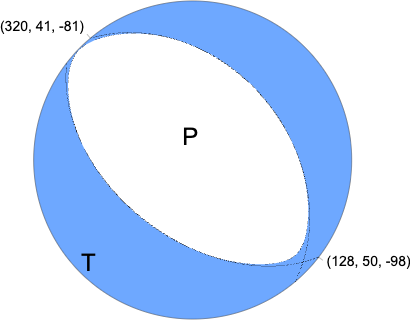
|
Magnitudes
Given the availability of digital waveforms for determination of the moment tensor, this section documents the added processing leading to mLg, if appropriate to the region, and ML by application of the respective IASPEI formulae. As a research study, the linear distance term of the IASPEI formula
for ML is adjusted to remove a linear distance trend in residuals to give a regionally defined ML. The defined ML uses horizontal component recordings, but the same procedure is applied to the vertical components since there may be some interest in vertical component ground motions. Residual plots versus distance may indicate interesting features of ground motion scaling in some distance ranges. A residual plot of the regionalized magnitude is given as a function of distance and azimuth, since data sets may transcend different wave propagation provinces.
ML Magnitude

Left: ML computed using the IASPEI formula for Horizontal components. Center: ML residuals computed using a modified IASPEI formula that accounts for path specific attenuation; the values used for the trimmed mean are indicated. The ML relation used for each figure is given at the bottom of each plot.
Right: Residuals from new relation as a function of distance and azimuth.

Left: ML computed using the IASPEI formula for Vertical components (research). Center: ML residuals computed using a modified IASPEI formula that accounts for path specific attenuation; the values used for the trimmed mean are indicated. The ML relation used for each figure is given at the bottom of each plot.
Right: Residuals from new relation as a function of distance and azimuth.
Context
The left panel of the next figure presents the focal mechanism for this earthquake (red) in the context of other nearby events (blue) in the SLU Moment Tensor Catalog. The right panel shows the inferred direction of maximum compressive stress and the type of faulting (green is strike-slip, red is normal, blue is thrust; oblique is shown by a combination of colors). Thus context plot is useful for assessing the appropriateness of the moment tensor of this event.
Waveform Inversion using wvfgrd96
The focal mechanism was determined using broadband seismic waveforms. The location of the event (star) and the
stations used for (red) the waveform inversion are shown in the next figure.
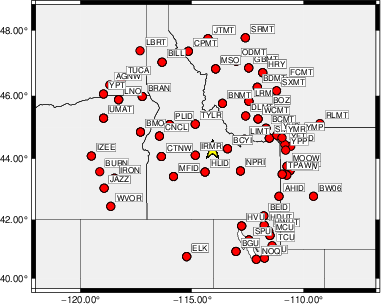
|
|
Location of broadband stations used for waveform inversion
|
The program wvfgrd96 was used with good traces observed at short distance to determine the focal mechanism, depth and seismic moment. This technique requires a high quality signal and well determined velocity model for the Green's functions. To the extent that these are the quality data, this type of mechanism should be preferred over the radiation pattern technique which requires the separate step of defining the pressure and tension quadrants and the correct strike.
The observed and predicted traces are filtered using the following gsac commands:
cut o DIST/3.3 -30 o DIST/3.3 +60
rtr
taper w 0.1
hp c 0.03 n 3
lp c 0.08 n 3
The results of this grid search are as follow:
DEPTH STK DIP RAKE MW FIT
WVFGRD96 1.0 0 70 -15 3.78 0.2933
WVFGRD96 2.0 175 75 -30 3.92 0.3660
WVFGRD96 3.0 175 85 -45 4.01 0.4105
WVFGRD96 4.0 170 80 -45 4.04 0.4529
WVFGRD96 5.0 170 80 -45 4.06 0.4836
WVFGRD96 6.0 170 80 -40 4.07 0.5087
WVFGRD96 7.0 170 80 -35 4.09 0.5272
WVFGRD96 8.0 155 55 -60 4.19 0.5588
WVFGRD96 9.0 160 55 -50 4.19 0.5703
WVFGRD96 10.0 165 60 -40 4.19 0.5704
WVFGRD96 11.0 165 60 -40 4.20 0.5655
WVFGRD96 12.0 170 65 -35 4.20 0.5567
WVFGRD96 13.0 170 65 -30 4.21 0.5461
WVFGRD96 14.0 170 65 -30 4.22 0.5323
WVFGRD96 15.0 175 70 -25 4.22 0.5184
WVFGRD96 16.0 175 70 -25 4.23 0.5030
WVFGRD96 17.0 175 75 -20 4.24 0.4877
WVFGRD96 18.0 175 70 -20 4.24 0.4726
WVFGRD96 19.0 175 70 -20 4.25 0.4575
WVFGRD96 20.0 175 65 -20 4.25 0.4435
WVFGRD96 21.0 175 65 -20 4.26 0.4321
WVFGRD96 22.0 175 65 -15 4.27 0.4207
WVFGRD96 23.0 175 65 -15 4.27 0.4097
WVFGRD96 24.0 180 75 20 4.27 0.3991
WVFGRD96 25.0 180 75 20 4.28 0.3933
WVFGRD96 26.0 180 75 20 4.29 0.3878
WVFGRD96 27.0 180 75 20 4.29 0.3823
WVFGRD96 28.0 180 75 20 4.30 0.3767
WVFGRD96 29.0 180 75 20 4.31 0.3710
The best solution is
WVFGRD96 10.0 165 60 -40 4.19 0.5704
The mechanism corresponding to the best fit is
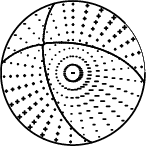
|
|
Figure 1. Waveform inversion focal mechanism
|
The best fit as a function of depth is given in the following figure:

|
|
Figure 2. Depth sensitivity for waveform mechanism
|
The comparison of the observed and predicted waveforms is given in the next figure. The red traces are the observed and the blue are the predicted.
Each observed-predicted component is plotted to the same scale and peak amplitudes are indicated by the numbers to the left of each trace. A pair of numbers is given in black at the right of each predicted traces. The upper number it the time shift required for maximum correlation between the observed and predicted traces. This time shift is required because the synthetics are not computed at exactly the same distance as the observed, the velocity model used in the predictions may not be perfect and the epicentral parameters may be be off.
A positive time shift indicates that the prediction is too fast and should be delayed to match the observed trace (shift to the right in this figure). A negative value indicates that the prediction is too slow. The lower number gives the percentage of variance reduction to characterize the individual goodness of fit (100% indicates a perfect fit).
The bandpass filter used in the processing and for the display was
cut o DIST/3.3 -30 o DIST/3.3 +60
rtr
taper w 0.1
hp c 0.03 n 3
lp c 0.08 n 3

|
|
Figure 3. Waveform comparison for selected depth. Red: observed; Blue - predicted. The time shift with respect to the model prediction is indicated. The percent of fit is also indicated. The time scale is relative to the first trace sample.
|
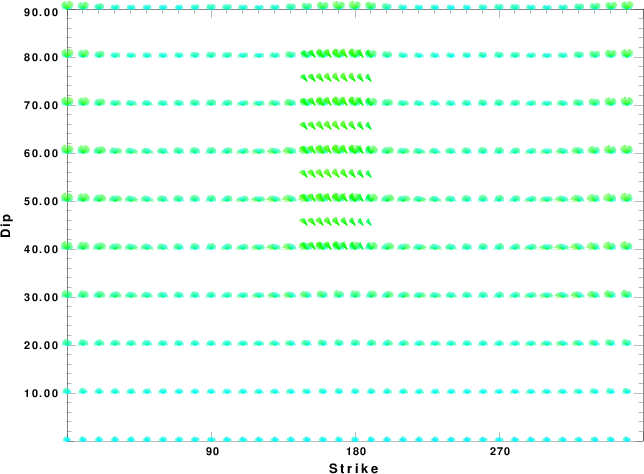
|
|
Focal mechanism sensitivity at the preferred depth. The red color indicates a very good fit to the waveforms.
Each solution is plotted as a vector at a given value of strike and dip with the angle of the vector representing the rake angle, measured, with respect to the upward vertical (N) in the figure.
|
A check on the assumed source location is possible by looking at the time shifts between the observed and predicted traces. The time shifts for waveform matching arise for several reasons:
- The origin time and epicentral distance are incorrect
- The velocity model used for the inversion is incorrect
- The velocity model used to define the P-arrival time is not the
same as the velocity model used for the waveform inversion
(assuming that the initial trace alignment is based on the
P arrival time)
Assuming only a mislocation, the time shifts are fit to a functional form:
Time_shift = A + B cos Azimuth + C Sin Azimuth
The time shifts for this inversion lead to the next figure:
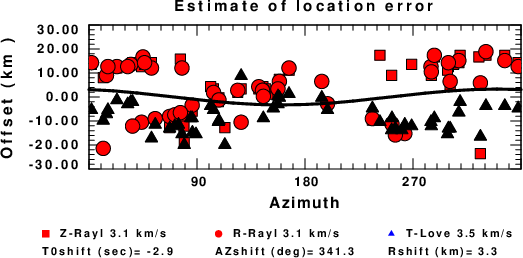
The derived shift in origin time and epicentral coordinates are given at the bottom of the figure.
Velocity Model
The WUS.model used for the waveform synthetic seismograms and for the surface wave eigenfunctions and dispersion is as follows
(The format is in the model96 format of Computer Programs in Seismology).
MODEL.01
Model after 8 iterations
ISOTROPIC
KGS
FLAT EARTH
1-D
CONSTANT VELOCITY
LINE08
LINE09
LINE10
LINE11
H(KM) VP(KM/S) VS(KM/S) RHO(GM/CC) QP QS ETAP ETAS FREFP FREFS
1.9000 3.4065 2.0089 2.2150 0.302E-02 0.679E-02 0.00 0.00 1.00 1.00
6.1000 5.5445 3.2953 2.6089 0.349E-02 0.784E-02 0.00 0.00 1.00 1.00
13.0000 6.2708 3.7396 2.7812 0.212E-02 0.476E-02 0.00 0.00 1.00 1.00
19.0000 6.4075 3.7680 2.8223 0.111E-02 0.249E-02 0.00 0.00 1.00 1.00
0.0000 7.9000 4.6200 3.2760 0.164E-10 0.370E-10 0.00 0.00 1.00 1.00
Last Changed Sun Jun 8 13:33:35 CDT 2025



